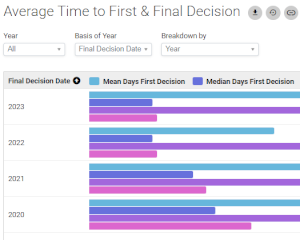An efficient submissions decision process is essential for maintaining the reputation of a journal, attracting and retaining good authors, and ensuring that research is disseminated to the scholarly community in a timely manner.
To this end, DataSalon’s PaperStack service provides a handy chart for tracking decision times, via the mean and median number of days from submission date to both the first decision and the final decision. The default view gives a year-on-year comparison across all journals, but it’s also easy to investigate the detail behind this overall picture.

Figures can be viewed at a monthly, instead of yearly, level – so you can see whether a normally efficient process experiences issues at particular times of year, perhaps over holiday periods.

The usual PaperStack chart breakdown and filtering options make it simple to home in on a particular journal, portfolio manager, and so on. Subject breakdowns are especially useful here, since expectations on decision times will vary for different disciplines – in some areas, a long decision-making process carries a real risk that the research will already be out of date by the time it’s published.

The chart is fully interactive, so to probe further into the reasons behind an issue you can simply click on any bar to view the list of articles – from which you can access a summary page for each article and a timeline of its reviewers and versions. This may highlight shared characteristics of articles with long decision times. Perhaps they have particular reviewers in common – who may simply be being asked to review too many articles at once. Perhaps there has been a large number of revisions, suggesting that the author might need some support in responding to reviewers’ feedback.
This chart is just one example of how PaperStack takes the vast amount of data available from your manuscript processing system and presents it in a way that provides you with actionable insights to improve the efficiency and effectiveness of your editorial process. If you’d like to see a demo of this and other reports, please get in touch with us.

